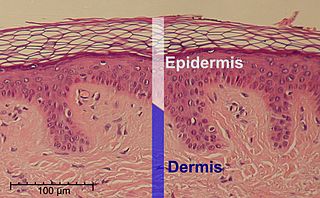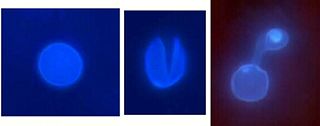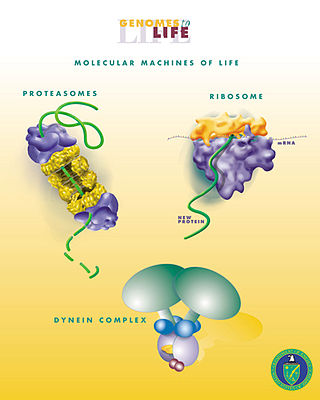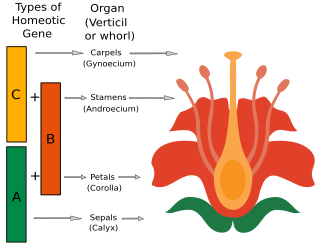Related Research Articles
Developmental biology is the study of the process by which animals and plants grow and develop. Developmental biology also encompasses the biology of regeneration, asexual reproduction, metamorphosis, and the growth and differentiation of stem cells in the adult organism.
Morphogenesis is the biological process that causes a cell, tissue or organism to develop its shape. It is one of three fundamental aspects of developmental biology along with the control of tissue growth and patterning of cellular differentiation.

In botany, a stoma, also called a stomate, is a pore found in the epidermis of leaves, stems, and other organs, that controls the rate of gas exchange between the internal air spaces of the leaf and the atmosphere. The pore is bordered by a pair of specialized parenchyma cells known as guard cells that regulate the size of the stomatal opening.

Keratinocytes are the primary type of cell found in the epidermis, the outermost layer of the skin. In humans, they constitute 90% of epidermal skin cells. Basal cells in the basal layer of the skin are sometimes referred to as basal keratinocytes. Keratinocytes form a barrier against environmental damage by heat, UV radiation, water loss, pathogenic bacteria, fungi, parasites, and viruses. A number of structural proteins, enzymes, lipids, and antimicrobial peptides contribute to maintain the important barrier function of the skin. Keratinocytes differentiate from epidermal stem cells in the lower part of the epidermis and migrate towards the surface, finally becoming corneocytes and eventually being shed, which happens every 40 to 56 days in humans.

The epidermis is the outermost of the three layers that comprise the skin, the inner layers being the dermis and hypodermis. The epidermis layer provides a barrier to infection from environmental pathogens and regulates the amount of water released from the body into the atmosphere through transepidermal water loss.

Trichomes are fine outgrowths or appendages on plants, algae, lichens, and certain protists. They are of diverse structure and function. Examples are hairs, glandular hairs, scales, and papillae. A covering of any kind of hair on a plant is an indumentum, and the surface bearing them is said to be pubescent.
Organogenesis is the phase of embryonic development that starts at the end of gastrulation and continues until birth. During organogenesis, the three germ layers formed from gastrulation form the internal organs of the organism.

Root hairs or absorbent hairs, are outgrowths of epidermal cells, specialized cells at the tip of a plant root. They are lateral extensions of a single cell and are only rarely branched. They are found in the region of maturation, of the root. Root hair cells improve plant water absorption by increasing root surface area to volume ratio which allows the root hair cell to take in more water. The large vacuole inside root hair cells makes this intake much more efficient. Root hairs are also important for nutrient uptake as they are main interface between plants and mycorrhizal fungi.

Propidium iodide is a fluorescent intercalating agent that can be used to stain cells and nucleic acids. PI binds to DNA by intercalating between the bases with little or no sequence preference. When in an aqueous solution, PI has a fluorescent excitation maximum of 493 nm (blue-green), and an emission maximum of 636 nm (red). After binding DNA, the quantum yield of PI is enhanced 20-30 fold, and the excitation/emission maximum of PI is shifted to 535 nm (green) / 617 nm (orange-red). Propidium iodide is used as a DNA stain in flow cytometry to evaluate cell viability or DNA content in cell cycle analysis, or in microscopy to visualize the nucleus and other DNA-containing organelles. Propidium Iodide is not membrane-permeable, making it useful to differentiate necrotic, apoptotic and healthy cells based on membrane integrity. PI also binds to RNA, necessitating treatment with nucleases to distinguish between RNA and DNA staining. PI is widely used in fluorescence staining and visualization of the plant cell wall.

An appressorium is a specialized cell typical of many fungal plant pathogens that is used to infect host plants. It is a flattened, hyphal "pressing" organ, from which a minute infection peg grows and enters the host, using turgor pressure capable of punching through even Mylar.

In cellular biology, mechanotransduction is any of various mechanisms by which cells convert mechanical stimulus into electrochemical activity. This form of sensory transduction is responsible for a number of senses and physiological processes in the body, including proprioception, touch, balance, and hearing. The basic mechanism of mechanotransduction involves converting mechanical signals into electrical or chemical signals.

The epidermis is a single layer of cells that covers the leaves, flowers, roots and stems of plants. It forms a boundary between the plant and the external environment. The epidermis serves several functions: it protects against water loss, regulates gas exchange, secretes metabolic compounds, and absorbs water and mineral nutrients. The epidermis of most leaves shows dorsoventral anatomy: the upper (adaxial) and lower (abaxial) surfaces have somewhat different construction and may serve different functions. Woody stems and some other stem structures such as potato tubers produce a secondary covering called the periderm that replaces the epidermis as the protective covering.

The ABC model of flower development is a scientific model of the process by which flowering plants produce a pattern of gene expression in meristems that leads to the appearance of an organ oriented towards sexual reproduction, a flower. There are three physiological developments that must occur in order for this to take place: firstly, the plant must pass from sexual immaturity into a sexually mature state ; secondly, the transformation of the apical meristem's function from a vegetative meristem into a floral meristem or inflorescence; and finally the growth of the flower's individual organs. The latter phase has been modelled using the ABC model, which aims to describe the biological basis of the process from the perspective of molecular and developmental genetics.
Turgor pressure is the force within the cell that pushes the plasma membrane against the cell wall.

A plant cuticle is a protecting film covering the outermost skin layer (epidermis) of leaves, young shoots and other aerial plant organs that have no periderm. The film consists of lipid and hydrocarbon polymers infused with wax, and is synthesized exclusively by the epidermal cells.

Hyaloperonospora parasitica is an oomycete from the family Peronosporaceae. It has been considered for a long time to cause downy mildew of a variety of species within the Brassicaceae, on which the disease can cause economically important damage by killing seedlings or affecting the quality of produce intended for freezing. Hyaloperonospora parasitica causes downy mildew on a wide range of many different plants. It belongs to the Kingdom Chromista, the phylum Oomycota, and the family Peronosporaceae. The former name for H. parasitica was Peronospora parasitica until it was reclassified and put in the genus Hyaloperonospora. It is an especially vicious disease on crops of the family Brassicaceae. It is most famous for being a model pathogen of Arabidopsis thaliana which is a model organism used for experimental purposes. Accordingly, the former Hyaloperonospora parasitica has been split into a large number of species. For instance, the taxonomically correct name of the parasite of the well-known model organism Arabidopsis thaliana is Hyaloperonospora arabidopsidis, not H. parasitica, whereas the pathogen of Brassica has to be called Hyaloperonospora brassicae.
BRI1-associated receptor kinase 1 is an important plant protein that has diverse functions in plant development.
Cell mechanics is a sub-field of biophysics that focuses on the mechanical properties and behavior of living cells and how it relates to cell function. It encompasses aspects of cell biophysics, biomechanics, soft matter physics and rheology, mechanobiology and cell biology.
Cell division orientation is the direction along which the new daughter cells are formed. Cell division orientation is important for morphogenesis, cell fate and tissue homeostasis. Abnormalities in the cell division orientation leads to the malformations during development and cancerous tissues. Factors that influence cell division orientation are cell shape, anisotropic localization of specific proteins and mechanical tensions.
Keiko Torii is a Japanese plant scientist and academic teaching at the University of Texas at Austin as of September 2019.
References
- ↑ Glover, B. J. (2000). "Differentiation in plant epidermal cells". Journal of Experimental Botany. 51 (344): 497–505. doi: 10.1093/jexbot/51.344.497 . PMID 10938806.
- ↑ Bidhendi, Amir J.; Lampron, Olivier; Gosselin, Frédérick P.; Geitmann, Anja (December 2023). "Cell geometry regulates tissue fracture". Nature Communications. 14: 8275. Bibcode:2023NatCo..14.8275B. doi:10.1038/s41467-023-44075-4. PMC 10719271 . PMID 38092784.
- ↑ Qian, P.; Hou, S.; Guo, G. (2009). "Molecular mechanisms controlling pavement cell shape in Arabidopsis leaves". Plant Cell Reports. 28 (8): 1147–1157. doi:10.1007/s00299-009-0729-8. PMID 19529941. S2CID 31893311.
- ↑ Bird, S. M.; Gray, J. E. (2003). "Signals from the cuticle affect epidermal cell differentiation". New Phytologist. 157 (1): 9–27. Bibcode:2003NewPh.157....9B. doi: 10.1046/j.1469-8137.2003.00543.x . PMID 33873705.
- ↑ Glover, B. J. (2000). "Differentiation in plant epidermal cells". Journal of Experimental Botany. 51 (344): 497–505. doi: 10.1093/jexbot/51.344.497 . PMID 10938806.
- ↑ Qian, P.; Hou, S.; Guo, G. (2009). "Molecular mechanisms controlling pavement cell shape in Arabidopsis leaves". Plant Cell Reports. 28 (8): 1147–1157. doi:10.1007/s00299-009-0729-8. PMID 19529941. S2CID 31893311.
- ↑ Zhang, C.; Halsey, L. E.; Szymanski, D. B. (2011). "The development and geometry of shape change in Arabidopsis thaliana cotyledon pavement cells". BMC Plant Biology. 11 (11): 27. Bibcode:2011BMCPB..11...27Z. doi: 10.1186/1471-2229-11-27 . PMC 3042916 . PMID 21284861.
- ↑ Bidhendi, Amir J.; Altartouri, Bara; Gosselin, Frédérick P.; Geitmann, Anja (July 2019). "Mechanical stress initiates and sustains the morphogenesis of wavy leaf epidermal cells". Cell Reports. 28 (5): 1237–1250. doi: 10.1016/j.celrep.2019.07.006 . PMID 31365867.
- ↑ Altartouri, Bara; Bidhendi, Amir J.; Tani, Tomomi; Suzuki, Johnny; Conrad, Christina; Chebli, Youssef; Liu, Na; Karunakaran, Chithra; Scarcelli, Giuliano; Geitmann, Anja (2019). "Pectin Chemistry and Cellulose Crystallinity Govern Pavement Cell Morphogenesis in a Multi-Step Mechanism". Plant Physiology. 181 (1): 127–141. doi:10.1104/pp.19.00303. ISSN 1532-2548. PMC 6716242 . PMID 31363005.